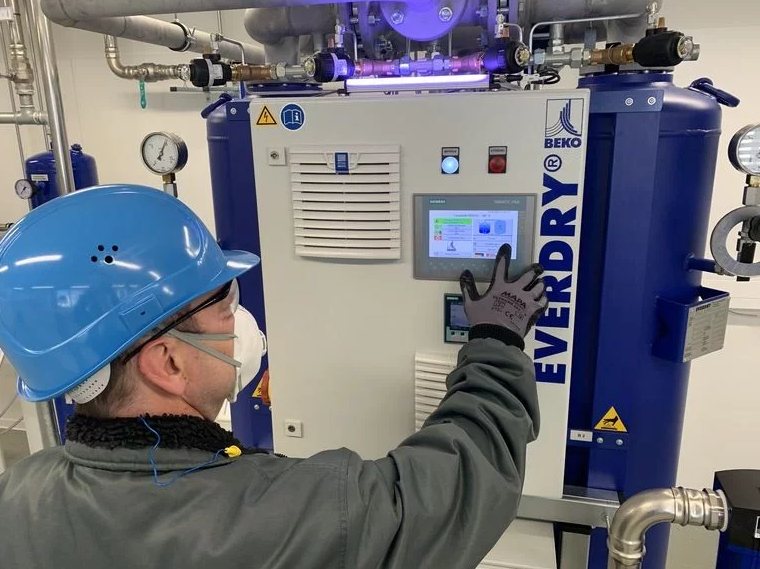The crisis situation caused many manufacturers to shut down their compressed air systems abruptly and without special precautions. In the event of full capacity utilisation to be expected in the future, the systems must not cause interruptions under any circumstances. Those who want to produce without interruptions should heed the following tips before restarting.

After lockdown: Safe restart of compressed air systems
Protection against "water hammer" through electronically level-controlled condensate drains
Temperature fluctuations cause condensation in the compressed air system. In the sinks of the piping and the containers, such as the compressed air tank or the filter, large amounts of water are deposited as so-called compressed air condensate during longer standstills. When the system is restarted, it shoots through the system as "surge water" and such a "water hammer" can lead to considerable problems such as burst filters. To prevent this, the compressed air system should be closely monitored during start-up. Those who have installed electronically level-controlled condensate drains are on the safe side in this case.
In addition, during the standstill phase, lubricants containing oil can collect on the surface in valves, fittings, etc., which are then carried along by the air flow and lead to contamination and oil contamination.
Sticky filter mats and overloading due to oil foam
It is possible that the intake filter mat in the compressor, which has not had air flowing through it for a long time, has become stuck. In spring and summer, the ambient air may be heavily polluted with pollen, which is deposited in front of the intake shafts. The increased flow resistance not only increases energy consumption, but may also lead to more oil vapour content in the compressed air. Before commissioning, the filter mats of compressors should therefore be checked and, if necessary, cleaned. The same applies to the surroundings of the intake shafts.
As the load decreases, the switching cycles of the compressors increase. With each load change, the internal pressure in the compressor relaxes, which can cause foam to form in the oil separator. If the switching times are shortened, there is not enough time for the foam to dissolve. This can lead to the oil separator element being enveloped by foam, additional oil reaching the clean side and causing the residual oil content to increase significantly. The downstream treatment can be overloaded to such an extent that the targeted compressed air quality is no longer achieved.
Compressed air filtration needs minimum volume flow
Downtimes cause oil in the filter medium to thicken and, because of the clogged filter pores, the differential pressure can increase so much that cracks appear and the material bursts open. The filter cartridges should be checked and, if necessary, changed before restarting. In addition, the filters have significantly less separation efficiency at low loads. Too low a volume flow can even cause some filters to fail completely.
Longer downtimes of the compressed air system also create ideal conditions for bacteria and germs, which are carried away uncontrollably from the filters during start-up. In this case, online sterilisation of the affected system sections is recommended, which does not require the removal of any components. Alternatively, contaminated filter elements can be sterilised again in an autoclave.
Compressed air de-oiling suffers from humidity and lack of flow
Furthermore, a system standstill may have an effect on the de-oiling of the compressed air with activated carbon adsorbers. If the activated carbon is saturated with condensation water, it cannot absorb oil when the system is restarted. Surge water also causes this problem. Before restarting, companies should check the components for moisture. Activated carbon adsorbers and adsorption dryers contain granulates and therefore always require a minimum flow rate for reliable oil removal.
Take measured values seriously in the case of partial utilisation
If a compressed air system is initially only partially utilised after it has been shut down, this poses a risk: It is possible that some components of the treatment system cannot work properly due to the volume flow being too low, which in turn leads to other components being overloaded. In such cases, apparently extreme measured values occur, which should by no means be regarded as a fault of the measurement technology. Instead, a functional check of the entire compressed air system must then be carried out.
Reduced heat exchange in the compressed air dryers
In the compressed air dryers, too, thickened oil sticks to the surface during longer standstills and the heat exchange is impaired. Flushing the heat exchangers with oil- and grease-dissolving cleaning agents provides a remedy.
Adsorption dryers use a granular desiccant and are always dependent on a certain flow rate. If the flow rate is too low, only partial total adsorption occurs and the compressed air is no longer sufficiently dehumidified. With suitable measurement technology, such undesirable effects can be detected.

Locking mechanism in steam traps
In steam traps, the mechanics of the floats can stick in the open or closed position. This leads to reduced performance or permanent discharge and thus to damage to other system components. It is advisable to replace or, even better, to use so-called zero-loss traps that operate with electronic level control.
Steam traps with time-controlled solenoid valves are often switched off during downtimes to save energy. When production is restarted, their activation must not be forgotten. The following also applies to these components: Microorganisms form in steam traps that have not been used for a long time and, in the worst case, are carried away in an uncontrolled manner during start-up.
Oil-water separator can overflow
If the drained condensate remains in an oil-water separator for a longer period of time, slime and blockages occur. The solid layers of oil hinder the function when restarting, even to the point of overflowing and thus contaminating the entire compressed air system. Before starting, the oil-water separator should therefore be cleaned and, if necessary, the filter should also be replaced.
Our authors
Horst Singer
Head of the International Service Centre

Wolfgang Dames
Head of Key Account Management for Pharma, Food, Chemicals and Automotive
